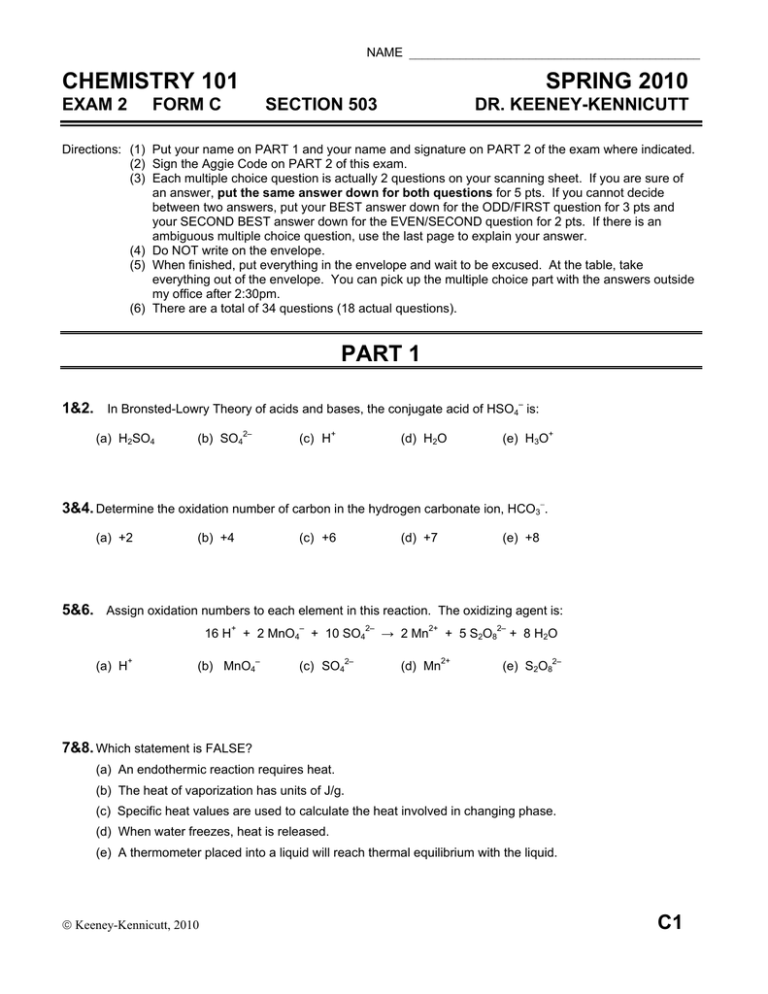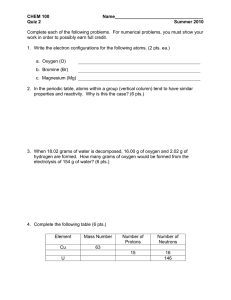CHEMISTRY 101 SPRING 2010 EXAM 2 FORM C
advertisement

NAME ______________________________________________ CHEMISTRY 101 EXAM 2 FORM C SPRING 2010 SECTION 503 DR. KEENEY-KENNICUTT Directions: (1) Put your name on PART 1 and your name and signature on PART 2 of the exam where indicated. (2) Sign the Aggie Code on PART 2 of this exam. (3) Each multiple choice question is actually 2 questions on your scanning sheet. If you are sure of an answer, put the same answer down for both questions for 5 pts. If you cannot decide between two answers, put your BEST answer down for the ODD/FIRST question for 3 pts and your SECOND BEST answer down for the EVEN/SECOND question for 2 pts. If there is an ambiguous multiple choice question, use the last page to explain your answer. (4) Do NOT write on the envelope. (5) When finished, put everything in the envelope and wait to be excused. At the table, take everything out of the envelope. You can pick up the multiple choice part with the answers outside my office after 2:30pm. (6) There are a total of 34 questions (18 actual questions). PART 1 1&2. In Bronsted-Lowry Theory of acids and bases, the conjugate acid of HSO4– is: (a) H2SO4 (b) SO42– (c) H+ (d) H2O (e) H3O+ 3&4. Determine the oxidation number of carbon in the hydrogen carbonate ion, HCO3−. (a) +2 (b) +4 (c) +6 (d) +7 (e) +8 5&6. Assign oxidation numbers to each element in this reaction. The oxidizing agent is: 16 H+ + 2 MnO4– + 10 SO42– → 2 Mn2+ + 5 S2O82– + 8 H2O (a) H+ (b) MnO4– (c) SO42– (d) Mn2+ (e) S2O82– 7&8. Which statement is FALSE? (a) An endothermic reaction requires heat. (b) The heat of vaporization has units of J/g. (c) Specific heat values are used to calculate the heat involved in changing phase. (d) When water freezes, heat is released. (e) A thermometer placed into a liquid will reach thermal equilibrium with the liquid. © Keeney-Kennicutt, 2010 C1 9&10. Here is a particle view of a substance in water. Pick the compound that is represented by this particle view. = cation or H = anion (a) NH3 (b) AgOH (c) RbOH (d) HF (e) FeS 11&12. Balance the equation with the SMALLEST WHOLE NUMBER COEFFICIENTS possible. Choose the number that is the SUM of the coefficients in the balanced equation. Don’t forget coefficients of one. Pb(NO3)2 Æ PbO + NO2 + O2 (a) 9 (b) 10 (c) 11 (d) 12 (e) 13 13&14. Consider this acid-base net ionic equation: HBrO(aq) + OH−(aq) Æ BrO−(aq) + H2O(l) Which of the following statements is TRUE? (a) The acid is a strong acid. (b) The base is insoluble. (c) The reaction is called a precipitation reaction. (d) The salt is a weak electrolyte. (e) The spectator ion could have been Na+ ion. © Keeney-Kennicutt, 2010 C2 15&16. Consider this illustration. Which statement is FALSE? (a) The substance may be water. (b) For Step 1: heat = Sp.Ht. x mass x ΔT (c) For Step 2: heat = Ht. of fusion x mass (d) The substance is being cooled to a solid at its freezing point. (e) At the intersection where Step 1 and Step 2 meet, the substance is a solid. . 17&18. The pH of a 0.000266 M solution of HClO4 is (a) 2.94 (b) 4.12 (c) 1.00 (d) 3.58 (e) 8.23 19&20. What mass of O2 could be produced by the decomposition of 25 g of KlO3? The unbalanced equation for the reaction is: KlO3 Æ KI + O2 (a) 6.7 g (b) 4.1 g © Keeney-Kennicutt, 2010 (c) 2.5 g (UNBALANCED) (d) 3.5 g (e) 5.6 g C3 21&22. If 8.51 grams of sodium sulfate, Na2SO4, are dissolved in 100.00 g of water, what is the percent Na2SO4 by mass in the solution? (a) 8.4% (b) 8.0% (c) 8.2% (d) 7.8% (e) 7.5% 23&24. What is the percentage yield of elemental sulfur if 7.54 grams of sulfur are obtained from the reaction of 6.00 grams of SO2 with an excess of H2S? 2 H2S + SO2 Æ 2 H2O + 3 S (a) 76.1% (b) 79.4% © Keeney-Kennicutt, 2010 (c) 83.8% (d) 88.4% (e) 91.4% C4 25&26. Consider the reaction: 2 KCrO2 + 3 H2O2 + 2 KOH → 2 K2CrO4 + 4 H2O If 20.0 g of each reactant were used for this reaction, the limiting reactant would be: (a) KCrO2 27&28. (b) H2O2 (c) KOH (d) K2CrO4 (e) H2O What concentration of HBr will be made when 45.0 mL of 2.00 M HBr is diluted to 100.0 mL? (a) 2.25 M © Keeney-Kennicutt, 2010 (b) 44.4 M (c) 0.0440 M (d) 0.900 M (e) 0.621 M C5 29&30. If 1.00 g of HCl was dissolved in enough water to give a pH of 2.04, what was the volume of the final solution? (a) 2.50 L (b) 3.00 L (c) 0.340 L (d) 0.811 L (e) 4.33 L 31&32. The iron in a 5.675 g sample of iron ore was first converted to Fe2+ ions, then titrated with 12.42 mL of 0.1467 M K2Cr2O7 according to the following balanced net ionic equation: 6 Fe2+ + Cr2O72– + 14 H+ Æ 6 Fe3+ + 2 Cr3+ + 7 H2O What is the percentage of Fe in the ore sample? (a) 1.536% © Keeney-Kennicutt, 2010 (b) 13.11% (c) 6.391% (d) 5.114% (e) 10.76% C6 CHEMISTRY 101 SPRING 2010 EXAM 2 Form C Section 503 NAME PLEASE BLOCK PRINT PART 2 Please read and sign: “On my honor, as an Aggie, I have neither given nor received unauthorized aid on this exam.” _______________________________________________ 33. Consider the precipitation reaction between aqueous solutions of sodium phosphate and copper(II) chloride. If you have problems with the nomenclature, make something up and go with that to get partial credit. (4 pts) (a) What is the balanced formula unit equation? Include the phase for every compound. (2 pts) (b) What is/are the spectator ion/s, if any? (2 pts) (c) What is the net ionic equation? Include the charge for every ion. OVER ⇒ © Keeney-Kennicutt, 2010 C7 34. Consider this reaction: N2 + O2 → NO2 . (2 pts) (a) Balance the equation. (3 pts) (b) If you had 4 moles of N2 and 4 moles of O2, draw the particle view that would represent the final situation. Let = N and =O Initial system Final system (2 pts) (c) What is the limiting reactant? ________________________ (5 pts) 35. A 588 g chunk of iron is heated to 97.5oC. It is then immersed in 247 grams of water originally at 20.7oC. The final temperature of both the iron and the water is 36.2oC. Calculate the specific heat of iron. The specific heat of water is 4.18 J/g•oC. © Keeney-Kennicutt, 2010 C8 SCRAP PAPER OR COMMENTS ON EXAM CHEMISTRY 101 Spring 2010 EXAM 2 Form C Section 503 © Keeney-Kennicutt, 2010 NAME C9




